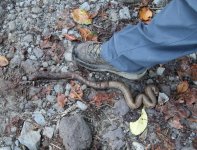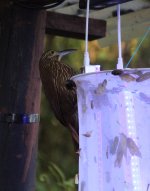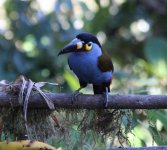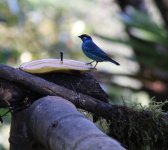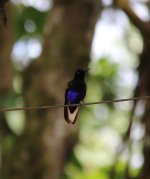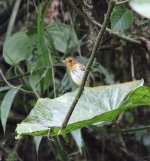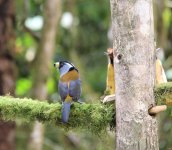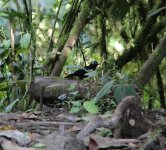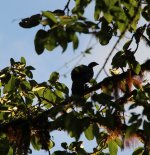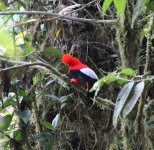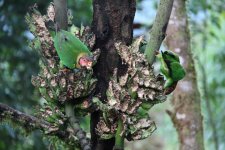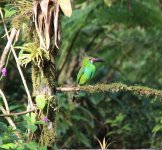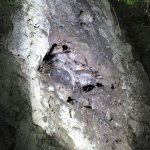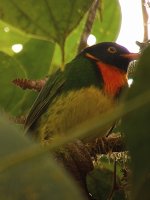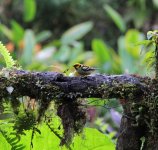Day 4 was another early morning long drive, in this case to Amagusa. In fact, this would be a day in which almost half of it was spent in a vehicle, with a total of 3 2-hour drives. EEK. The goal here was to bird Amagusa at first light, and after lunch drive to Chontal for the oilbirds, and from here drive back to Mindo. It's not an ideal itinerary: I would strongly recommend if folks are going after the Oilbird to see if you can just do a day for that, because pairing Oilbird with Amagusa makes a kind of brutal day.
Amagusa Reserve however was well worth the visit, and the morning would be pretty decent with most target seen. Our first stop was the light, which attracts and assortment of insects that in turn bring the insect-eating birds in first thing in the morning. Within the vicinity of the light we had
Pacific Tuftedcheek (which is actually nesting above the light, the equivalent of renting an apartment above a pizza place),
Cinnamon Becard,
Black-billed Peppershrike, Linneated and Scaly-throated Foliage-gleaner, Zeledon's Antbird, and
Dusky-capped, Golden-bellied, and Slaty-capped Flycatchers. A good haul of species in what was probably less than half an hour I would guess. Some fruit was also put out, which provided point-blank views of
Rose-faced Parrots, a Choco speciality of the site. We then checked out another set of feeders, passing a cooperative
Indigo Flowerpiercer on the way, another site specialty. A range of different birds were in this vicinity, most of which we had seen elsewhere, although I think
Bay Wren was new for the trip, as were a pair of
Plumbeous Pigeons. The fruit feeders attracted
Moss-backed and
Glistening-Green Tanagers, alongside Golden and Flame-rumped.
We then walked the road the short distance to the gate of the Milpe Lodge. This private lodge does not allow visitors sadly, even though the grounds have some good Choco specialities hard to get elsewhere. It also charges, according to Nelson, a $1000 dollars a night. For that price, there better be Tinamous taking my luggage to my room! You got a sense of how birdy the lodge trails must be, since one of the most productive spots was literally the area around the gates marking private access. There was a lot of activity here: A
Collared Trogon perched in the tree, while a
Green-fronted Lancebill was nesting in a nearby small building. We also had visits by the recently split
White-throated Daggerbill, a hummer that I don't think frequents feeders really. A mixed flock had our first
Flame-faced Tanagers, a bird I really thought I would have seen by now: Summer is a poor time of year for tanagers, as their is more food and so less need to chill out by feeders. We also had
Streak-headed Treehunter here, and a pair of
Esmeraldas Antbirds skulked low down. One of the main specialties here is the rare
Choco Vireo, and we were fortunate to have one in the bare branches of a tree over the gate, affording good looks. Upon walking back to the feeder/comedor area revealed new birds. A
Swallow Tanager perched high above the road in a bared tree, not behaving much like a typical tanager. a mixed flock included the only manakin of the trip it would turn out: a rather unexciting female
Golden-winged Manakin, and also some underwhelming female
Golden-collared Honeycreepers. While this was going on, a guide with a group of clients from Milpe Lodge ventured past us. The guide knew Nelson, because seemingly Nelson knows everyone even remotely related to birding in the area

. The clients were I think mostly from Europe, and were obviously not birders, and just sort of doing this birding walk as a tourist thing to do. While Nelson honed in on what would be a Black Solitaire, the Milpe guide had corralled a snake he identified as a
Crowned Centipede-snake, a rear-fanged venomous snake that effectively posed no danger to humans. Although Nelson said instead it was an entirely different snake. I am not sure if this was a case of taxonomic revisions, but I am going with the Crowned Centipede-snake as its listed as common for the area and the Milpe guide got a better view of it than either of us, since by the time I saw it, its head was already undercover.
Missing the cooperative solitaire from earlier, we spent some time trying for it. Thankfully it didn't put up much of a fight, and good views were had of
Black Solitaire. This is another speciality of the site and is a gorgeous black-and-white thrush, and well worth tracking down. We also heard Andean Solitaire, however this bird didn't feel like playing.
We made our way back to the comedor and feeder area. The hummer feeders here attracted a mix of species that were mostly birds seen at Bellavista or Milpe, but there was one additional target here that was new:
Empress Brilliant, and soon enough we had this bird. The fruit-feeders brought in some new birds for the day, including Black-chinned Mountain-Tanager and Orange-bellied Euphonia, and better views were had of Flame-faced Tanager. At this point another band of tourist showed up, as a guided tour for the Chinese Bird Photography Association showed up, and a parade of folks with cameras that probably cost more than my car lined up at the fruit-feeders. Word passed down that a pair of male Golden-collared Honeycreepers had come down to the feeder, but they were gone by the time I got to the correct ones. Fruit-feeders were not great after this, not because birds weren't coming in but just with the crowding. In their defense, they were polite, it was more my anxiety (I am not good with crowds) that made it not a fun experience.
From here, and prior to lunch, we walked up the road, using playback and just keeping our eyes open for new birds. Birding was slower here and required a bit more work, but eventually added birds to the trip list. I believe we had a decent mixed flock here (at this point some of the exact sequences of events are becoming blurred from the whirlwind trip. This flock contained birds we had seen earlier, but also some new species, including
Blue-necked Tanager,
Uniform Treehunter, and
Andean Solitaire. We tried for quite some time to get a
Uniform Antshrike into view, and managed kind of crappy but at least countable views.
Orange-breasted Fruiteater was more cooperative and good views were had of I think both male and female birds. Playback was needed to coax out a
Bronze-Olive Pygmy-Tyrant, a bird that if we missed here we would probably miss for the trip. Not needing any coaxing at all was a
Common Tody-Flycatcher, the
sclateri form which is a potential split from the birds I saw in Panama.
After this, we had a good lunch at the cafe, amusing myself as much with the cute dog (named Junior) that one of the cooks brought with her as I did with the birds. There was some final frustration here. Soon enough the bird photographers made there way to the cafe. One of whom was awesome enough to decide the best place for him to rest and have lunch was to sit on the low wall RIGHT IN FRONT OF THE FEEDERS, blocking them from view for just about anyone. It's one thing to being blocking view for photos, but he was turned away and not even paying attention to this set of feeders. Needless to say, I never got a male Golden-collared Honeycreeper. Otherwise however, we pretty much got all our targets here, and it was a satisfying morning of birding.
Now...it was onward to Chontal and Oilbirds!





